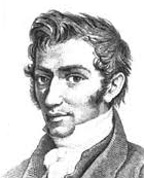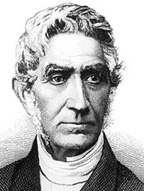Tales of Statisticians
Adolphe Quetelet
22 Feb 1796 - 17 Feb 1874Quetelet was born in Ghent, to a French father who had established himself there ten years earlier, and a Brabantine mother. The son successfully negotiated the upheavals which were being caused by the 1790 transition from the Austrian to the French Republican educational structures in the Austrian Netherlands, showing in the process a talent for the uses to which new institutions can be put. This skill was to serve him well in later life.
His father's death in 1803 left the family in want, and after leaving the Ghent Lycée in 1813, Quetelet became a mathematics teacher in the Ghent municipal college. At this time he was much interested in the arts. He apprenticed to a painter, turned out acceptable paintings of his own, wrote poetry, and with his friend and fellow Franco-Belgian Germinal Dandelin, collaborated on an opera. The University of Ghent was founded in 1817. In 1819, Quetelet received its first doctoral degree, for a thesis on the focal curve (a result improved on in 1822 by his no less versatile operatic collaborator Dandelin). In October of that year, equipped with this new distinction, he became a professor in Brussels, the city where he was to live for the rest of his life.
In 1823 Brussels became again part of the southern Netherlands. Quetelet made contact with the Minister of Public Education, and interested him in the founding of an observatory in Brussels. Quetelet was sent to Paris to learn the requisite techniques. Among the things he learned, from contacts with Laplace, Fourier, and Poisson, was the central importance of probability theory in astronomy.
Back in Brussels, Quetelet gave popular lectures at the Brussels Museum on probability as well as astronomy and physics; he added to his knowledge (and his collection of scientific instruments) by visiting other centers; he founded a journal. In 1826, being increasingly interested in the social aspect of his probability studies, he published a paper on the laws of births and mortality in Brussels, and subsequently advocated a complete population census, which was ordered by the government in 1828. In that year, Quetelet was appointed astronomer of the Brussels Observatory (which at that time was still 4 years short of completion).
This appointment survived the Belgian Revolution of September 1830, and Quetelet, now a Belgian, remained a scientific and public figure of importance for the next quarter century. In 1834 he was elected Permanent Secretary of the Brussels Academy of Arts and Sciences (later the Royal Academy of Belgium), and held that position until his death. Also in 1834, the Brussels Museum was absorbed into the new University of Brussels, and Quetelet's series of lectures, still popular, and indeed drawing European audiences, was ended. He declined a chair in the University, and in 1836 resumed his lectures at a new venue: the Military School of Brussels (founded in 1834). His broader public included a total roster of more than 2,500 correspondents, from the American President Garfield (who asked about improving the American census) to Gauss, and not excluding Goethe, who showed Quetelet special hospitality when he visited Germany in 1829.
At first, the normal curve had been invoked chiefly in the study of observational errors in astronomy. But the circle of Laplace, especially Poisson, had also been interested in social applications. Quetelet pursued this line. He considered such individual phenomena as variation in body measurements (an interest going back to his period as a painter) and such social phenomena as the incidence of crime. In 1831 he issued pamphlets on both these subjects. In the latter, he enunciated his two central principles for the study of mankind at large:
First: Causes are proportional to the effects they produce. If a man can lift twice as much as another man, he is twice as strong as that man. Study of man's moral qualities is possible only if this principle can be applied to them also.
Second: Exact conclusions are possible only with large numbers. "The greater the number of individuals, the more the influence of the individual will is effaced, being replaced by the series of general facts that depend on the general causes according to which society exists and maintains itself."
The moral regularities, the aggregates of individual choice, which Quetelet himself investigated included age-specific crime rates for men and (separately) for women. These results were included in a larger treatise, published in 1835, on the development of human faculties, with the controversial subtitle Essai de Physique Sociale. Also arousing lively reaction was a term used in the book: l'homme moyen, the demographically average man, the human being with his individual wishes and peculiarities canceled out, and thus entitled to represent the nation. Questions of determinism arose. Discussion ensued. The discussion did nothing to damp Quetelet's reputation, and in 1836 he became the tutor of Albert of Saxe-Coberg, who later, as "Prince Albert," the consort of Queen Victoria, facilitated Quetelet's contacts with British scientists, including Babbage and Malthus. The excitement aroused by these visits among English scientists had an influence on the later establishment of the Statistical Society of London (subsequently the Royal Statistical Society), and contributed their share to determining the style and scope of later British statistics, and indeed social thought. Prince Albert's address to the fourth meeting of the International Statistical Congress (London, 16 July 1860) unmistakably shows the continuing influence of his tutor Quetelet.
To the 1869 second edition of his 1835 treatise (in which the controversial subtitle became the main title), Quetelet added observed regularities in the number of suicides from year to year, and in the rate of marriage for each sex and age group. This "moral statistics" of Quetelet is the distant progenitor of the modern science of sociology.
Quetelet did not find in these observed social regularities evidence of divine will, as some had done. He attributed them to social conditions, which were themselves liable to change or be changed. In social phenomena, he found two levels of causation:
One is the constant factors of age, sex, profession, educational level, and economic and religious situation. The seasons are a fluctuating, but predictably fluctuating, example of a constant factor. Quetelet considered and analyzed these factors in various combinations, in the process anticipating the multivariate analysis of later times.
Any free will admitted to the equation (and at times, Quetelet seemed to assign it little or no effect) is in the category of accidental or "perturbative" causes, not operating in a constant direction, and tending to cancel out when humanity is considered in bulk. Such effects are like variations from probability in a tossed coin; unpredictable, but tending to average out in the long run.
In 1844 he first published the fact that variations in physical characteristics were symmetrically distributed about the mean, as would be anticipated by the binomial or normal distribution. He was able to derive a theoretical frequency distribution which closely predicted the observed variation in height, weight, or chest circumference of various groups in the population. This has philosophical import: it assigns the human ideal not (say) to the most evolved extreme, the highest end of the distribution, as cultured persons had invariably done up to that time, but rather to the term in the middle, the least extreme, the value with the most examples in that population.
That shift of emphasis in effect made the "average man" the ideal citizen.
In most of Quetelet's work, however, there are very few numbers. He worked with the numbers at his disposal, essentially those available from public records. The social biometrics of the English school in the early 20th century can be seen as a systematic effort to provide Quetelet's theories with facts upon which they can be properly tested. Quetelet also failed to adequately separate what he sometimes called latent tendency, though he identified it very clearly:
"This probability may be considered as giving, in cities, the measure of the apparent tendency to marriage of a Belgian aged 25 to 30. I say apparent tendency intentionally, to avoid confusion with the real tendency, which may be quite different. One man may have, throughout his life, a real tendency to marry without ever marrying; another, on the contrary, carried along by fortuitous circumstances, may marry without having the least propensity to marriage. The distinction is essential." (1848)
Among the philosophical issues raised by Quetelet's theory of social regularity, and also by the contemporary writings of Buckle, are questions of individual free well, and, ultimately, of individual responsibility for crime. In Quetelet's own formulation, "Society prepares the crime, and the guilty person is only the instrument by which it is executed" (1835). An opposing German school, headed by Wilhelm Drobisch, argued on the contrary that individual will is not some practically negligible factor, but the prime determinant of action. Equally controversial are questions of the effect, and the desirability, of legislation intended to improve social conditions.
Quetelet's statistical activity reached a peak of influence when he organized the first international statistical conference in 1853. A stroke in 1855 left him still active but no longer productive, and the last twenty years of his life were spent in diplomatic and literary support of previously held positions. The early measurement work of Quetelet is trivially memorialized in the Quetelet Index of Obesity.
To put it in non-Continental terms: height in inches squared, divided by 23.4, equals the weight in pounds of the QI threshold.
The policy debate which Quetelet's social statistics engendered raged until the end of the nineteenth century and burned on through the twentieth. Philosophically, it is still with us. It is his larger legacy.
Statistics is Copyright © 2001- by E Bruce Brooks
4 Sept 2004 / Contact The Project / Exit to Statistics Page

